Gochujang Noodles (Spicy Korean Noodles)
Treat yourself to a quick and easy meal with these spicy gochujang noodles. The Korean gochujang noodle sauce gives this bowl of noodles a stellar umami kick. Add a cooked egg, some tofu or leftover veggies to bulk up the meal.
Gochujang noodles are a quick, flavour-packed meal to rustle up when you just don’t have the energy to cook a big dinner. I think of it as the type of simple meal a tired chef (or food blogger) wants after a day in the kitchen. Easy, simple, minimal washing up, quick, flexible, but singing with spicy umami flavours.
And the star of the show? The gochujang noodle sauce.
Gochujang — the savoury, spicy, and slightly sweet Korean red chilli paste — is the key ingredient in this delicious noodle dish. Combined with a few pantry staples, like toasted sesame oil, soy sauce and rice vinegar, it creates a flavourful Korean sauce that clings to the noodles and delivers loads of flavour.
The portions are on the smaller side, but super easy to bulk up if you’re very hungry. (Also, no one is judging you for eating a double portion if you feel like it.) Treat this spicy Korean noodle dish as a blank canvas and bulk it up with stir-fried veggies and tofu, or top it with a fried egg (if you don’t need it to stay vegan).
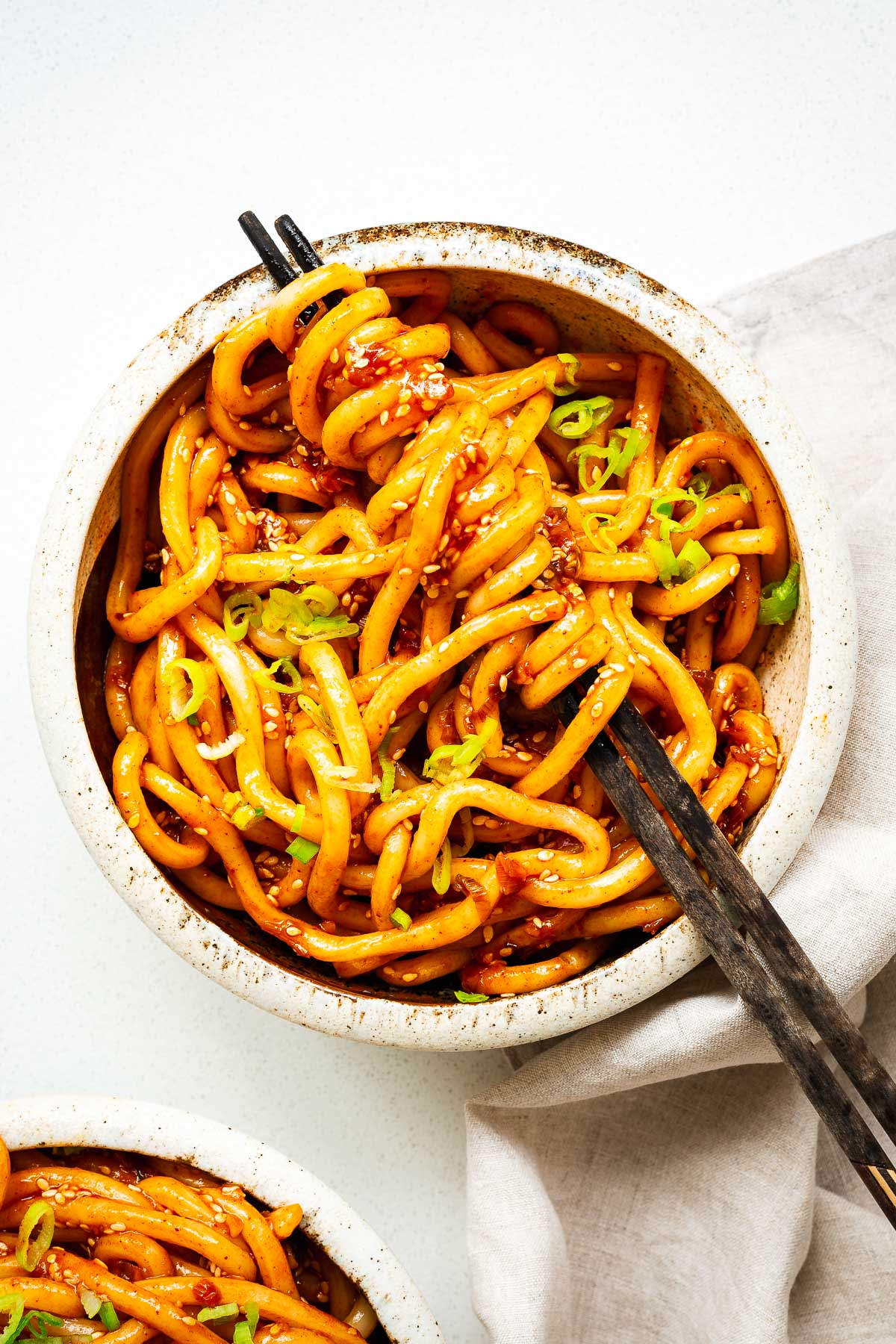
Why I love these noodles
- It’s perfect for busy weeknights: This quick-and-easy spicy Korean noodle recipe comes together in less than 15 minutes. It’s almost as quick as instant spicy Korean noodles – but so much better.
- It’s vegan-friendly: The noodle recipe as written is vegan. But you can add a fried egg for those who don’t need it to be, or crispy tofu for those who do.
- It’s versatile: Use fresh udon noodles, dried ramen noodles, or even rice noodles. And adjust the heat to your preference. Use more gochujang paste or gochugaru (Korean chilli flakes) for more heat. Or tone it down with a dollop of creamy peanut butter.
- It’s great for a fridge raid: Add all those veggies lurking in the back of the fridge, or those last snippets of kimchi with a handful of edamame beans.
- It’s utterly delicious: The gochujang noodle sauce is a serious flavour bomb. It’s a balance of sweet, spicy, salty and tangy.
Ingredients and substitutes
This gochujang noodle sauce is a great way to amp up your noodle game. It clings to chewy noodles to flavour every bite.
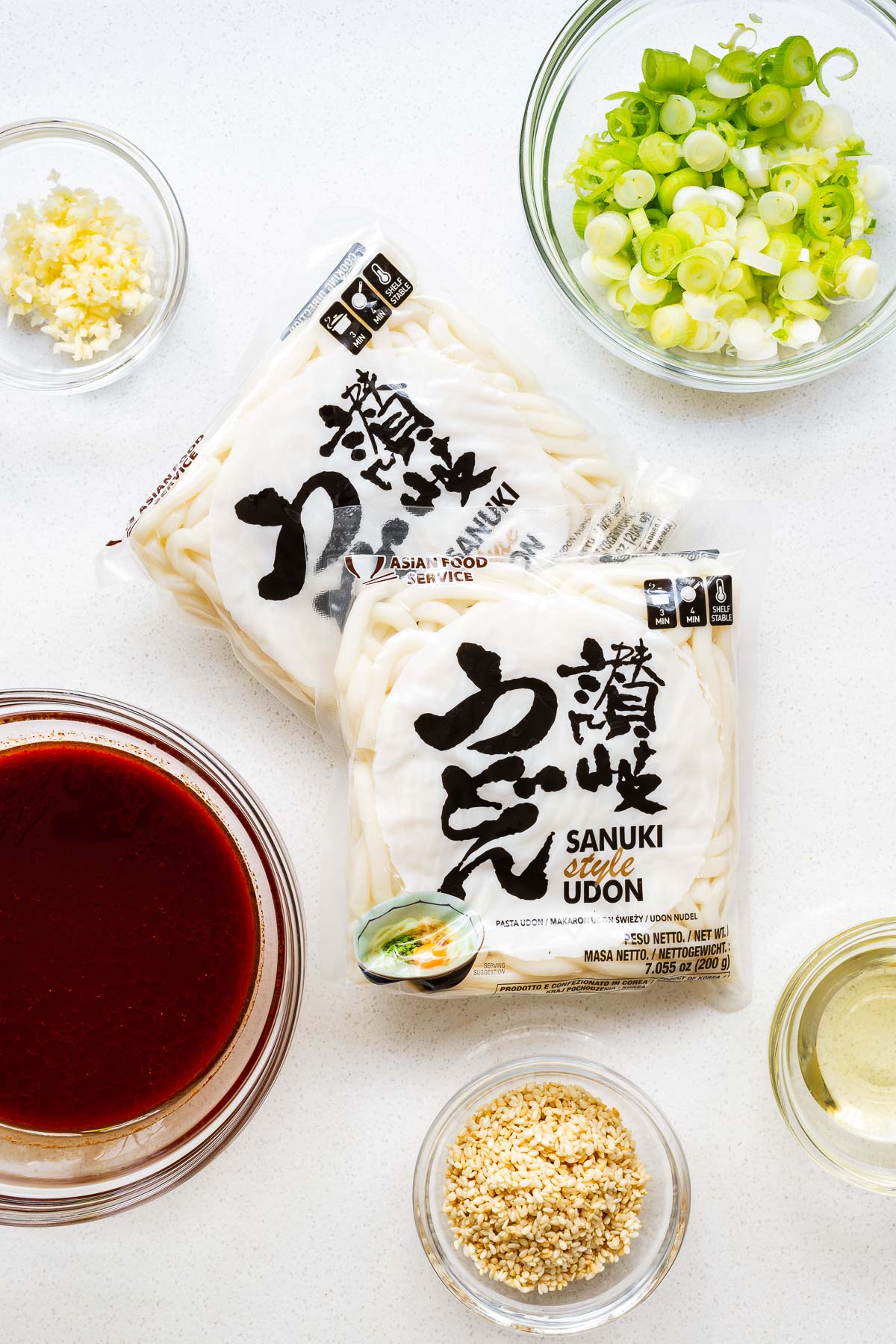
Which noodles work best?
I love how the gochujang noodle sauce clings to thick and chewy udon noodles. But you can really use any Asian wheat noodles (or even rice noodles) in this recipe.
You will find par-cooked fresh udon noodles on the shelf with the dry noodles in the grocery store, not in the fridge. They come in vacuum-sealed plastic sachets that are pre-portioned.
The recipe calls for packaged fresh udon noodles, roughly 7 ounces (200 grams) per portion. However, different countries have different portion sizes for packaged noodles. There is enough sauce for 7 to 8 ounces per portion. Any larger and you’ll have to make more sauce.
Check the package instructions for dried noodle portions. Different types of dried noodles will absorb water differently. And 8 ounces of dried noodles will be way too much! For example, an instant ramen noodle portion is roughly 2 ounces.
Gochujang noodle sauce ingredients
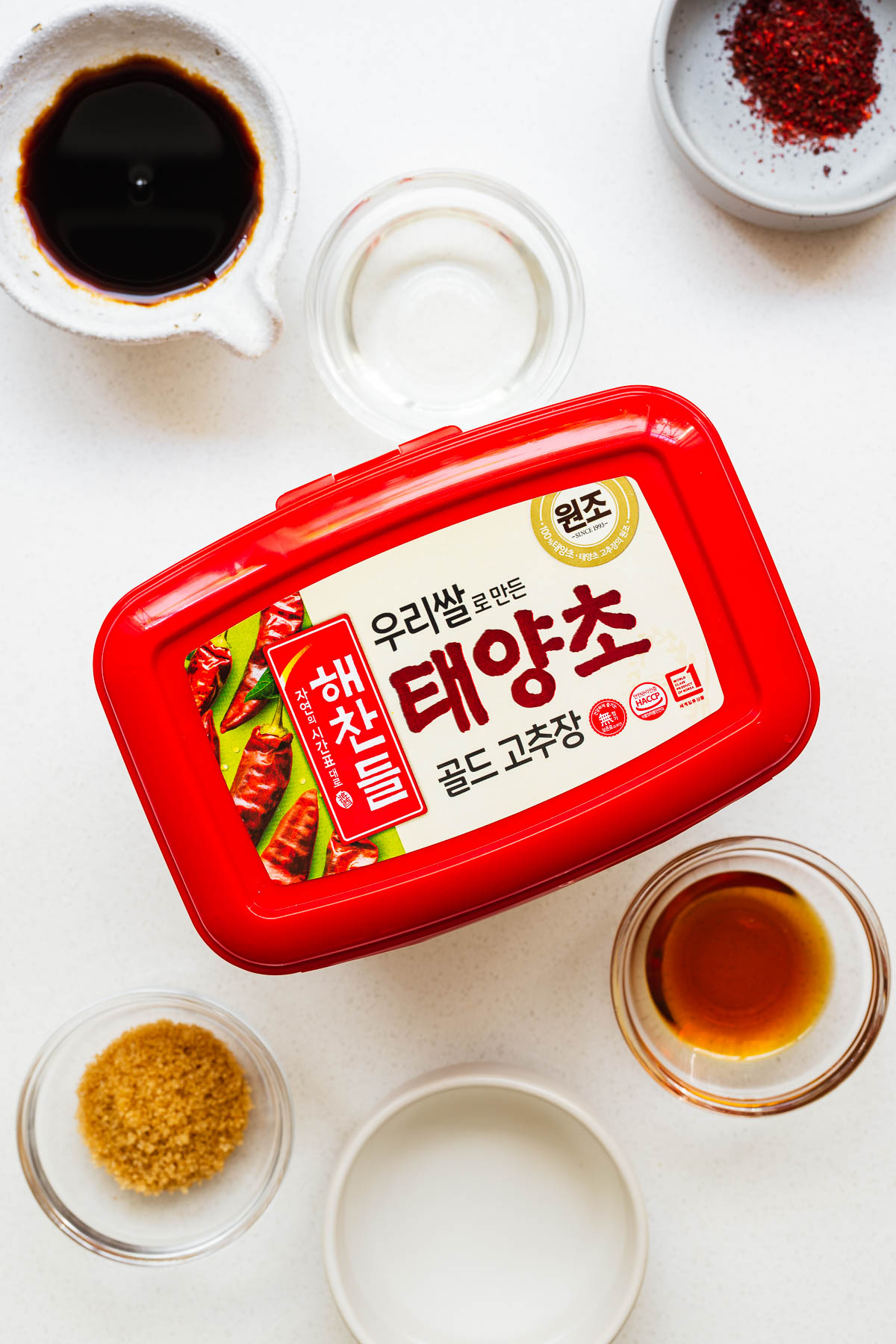
- Green onions: If you don’t have green onions (scallions) or spring onions, you can use finely chopped shallots or regular onions. Or sprinkle the finished dish with chives.
- Garlic: Freshly minced garlic cloves are my go-to. But you can also use garlic paste – just be mindful of burning the garlic paste.
- Gochujang paste: The star of the show! Gochujang is a Korean chilli paste. It is available in different levels of spiciness: Mild, Slight Hot, Medium Hot, Very Hot and Extreme Hot. I buy mine medium hot and add gochugaru (Korean chilli flakes) if I want more heat. If you can’t find gochujang, learn more about gochujang and how to substitute it.
- Soy sauce: Use all-purpose or light soy sauce, not dark soy sauce (the flavour is too strong).
- Water: Just to thin out the spicy gochujang sauce. You can also use chicken, vegetable or mushroom stock for an additional splash of flavour.
- Toasted sesame oil: This nutty-flavoured oil adds depth and complexity to the gochujang sauce. If you don’t have any, you can substitute it with regular sesame oil, but the flavour won’t be quite the same.
- Rice vinegar: Rice vinegar adds a sweet-sour flavour to the gochujang noodles. If you don’t have any, use mirin, red wine vinegar, or white wine vinegar instead.
- Brown sugar: The sweetness helps to balance the heat and acidity. It also makes the sauce sticky to better cling to the noodles. You can use any type of sugar or syrup. I also like to make the sauce with maple syrup.
- Gochugaru (Korean chilli flakes): This optional ingredient adds some extra heat. If you don’t have any, see these gochugaru substitutes for an equivalent red pepper flake. Or use a sliced fresh chilli pepper if you need the extra heat.
To cook the noodle dish, you can use any neutral-tasting oil like canola, peanut, or vegetable oil. And, finish the noodles with toasted sesame seeds and reserved green onions.
How to make spicy Korean noodles
These spicy Korean noodles are an easy, flavourful and comforting meal. Follow these simple steps to get a bowl of spicy noodles on the table in 15 minutes.
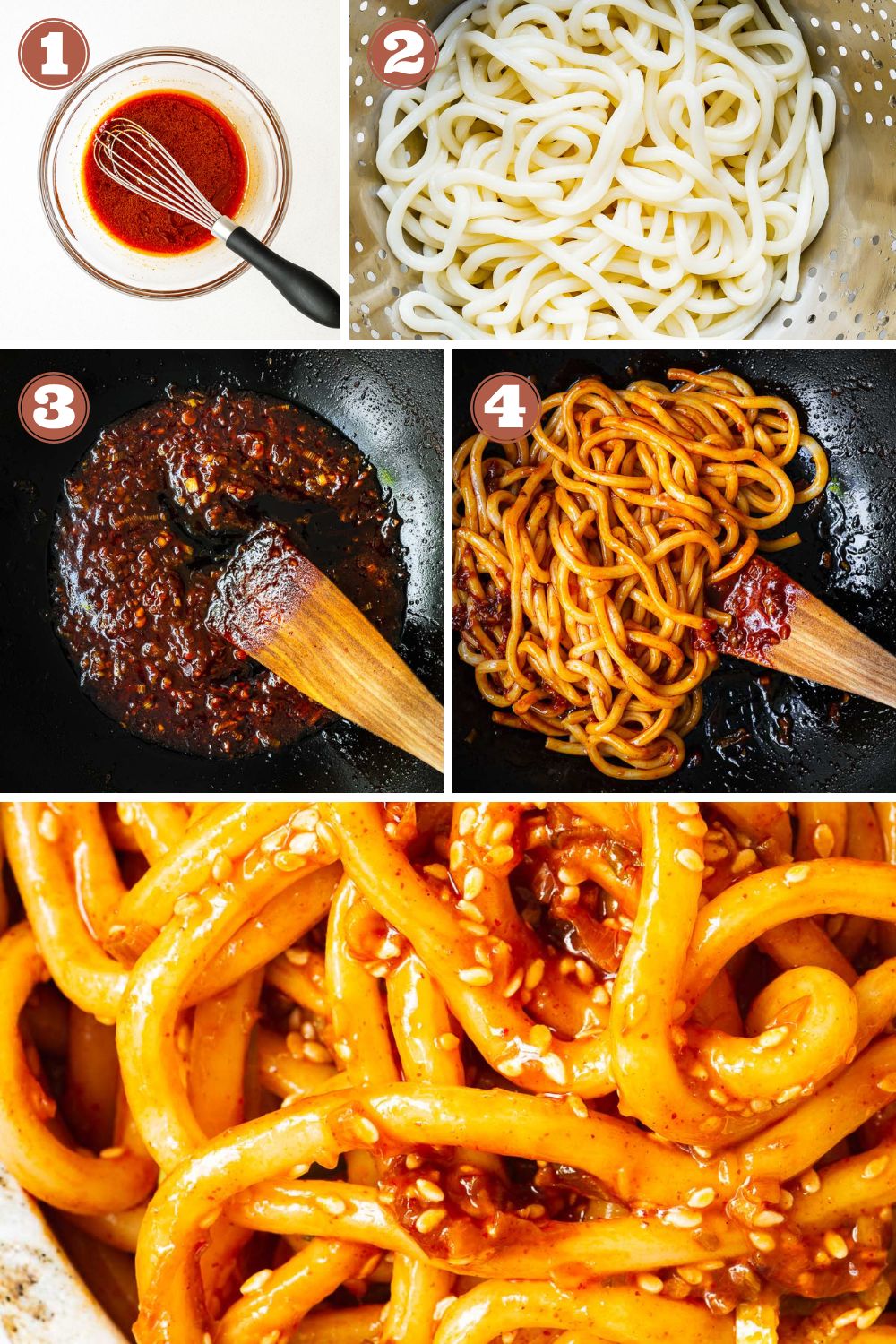
Step 1: Make the gochujang noodle sauce
Whisk together the gochujang sauce ingredients in a small bowl:
- two tablespoons of gochujang paste with
- two tablespoons of soy sauce,
- two tablespoons of water,
- one tablespoon of toasted sesame oil,
- two tablespoons of rice vinegar,
- one tablespoon of brown sugar, and
- one teaspoon of gochugaru (Korean chilli flakes) or red pepper flakes (optional if you want to add more heat).
Tip: Taste the noodle sauce before you add the chilli flakes. I prefer my noodles spicier than my husband does. When I’m cooking for both of us, I’ll sprinkle my finished gochujang noodle bowl with gochugaru instead of adding it to the sauce. Or I’ll add a cheeky dollop of homemade sambal oelek for extra spice. But if I’m cooking for myself, I’ll even add another tablespoon of gochujang paste!
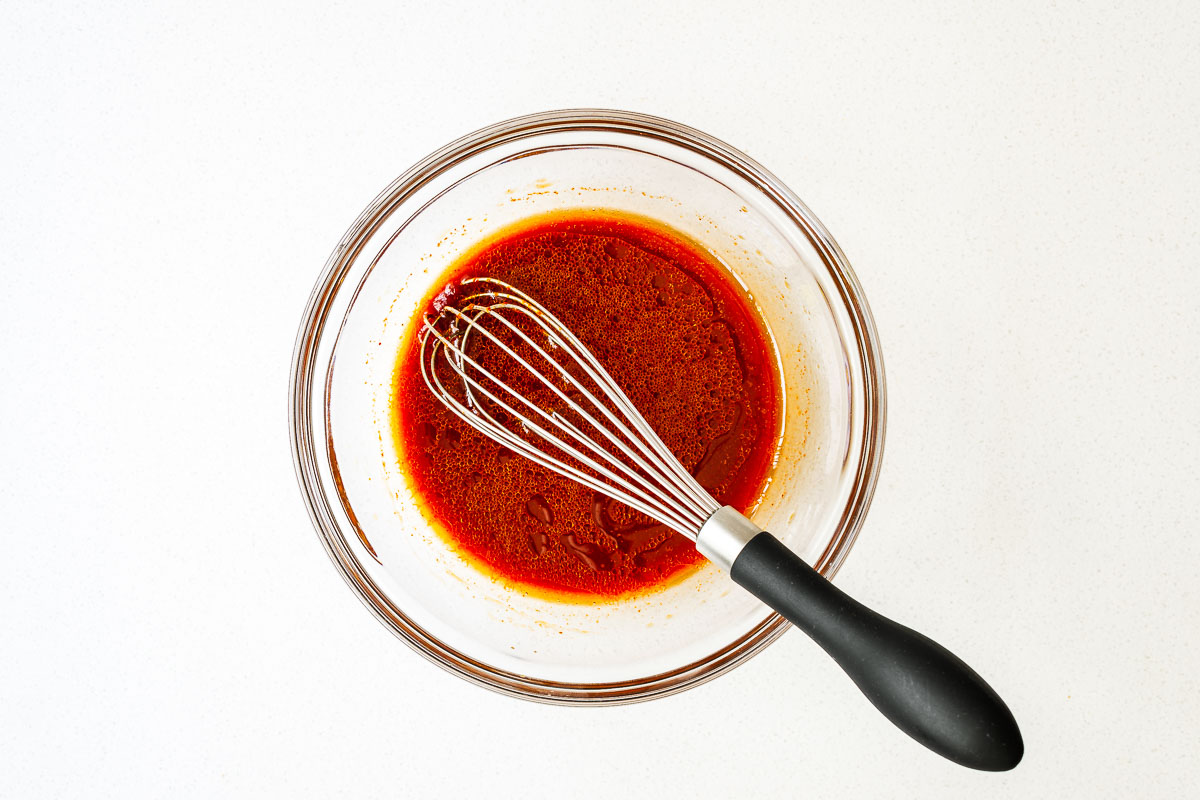
Step 2: Cook the noodles
Boil fresh udon noodles for 2 minutes (add a minute for frozen udon noodles) until the noodle cake starts separating into noodle strands. Remove the pot from the heat. Then use chopsticks to wiggle into the noodles and gently separate them.
Cook dried noodles according to the package instructions for a minute short of the full cooking time.
Strain the cooked noodles in a colander and rinse them with cold running water to stop them from overcooking.
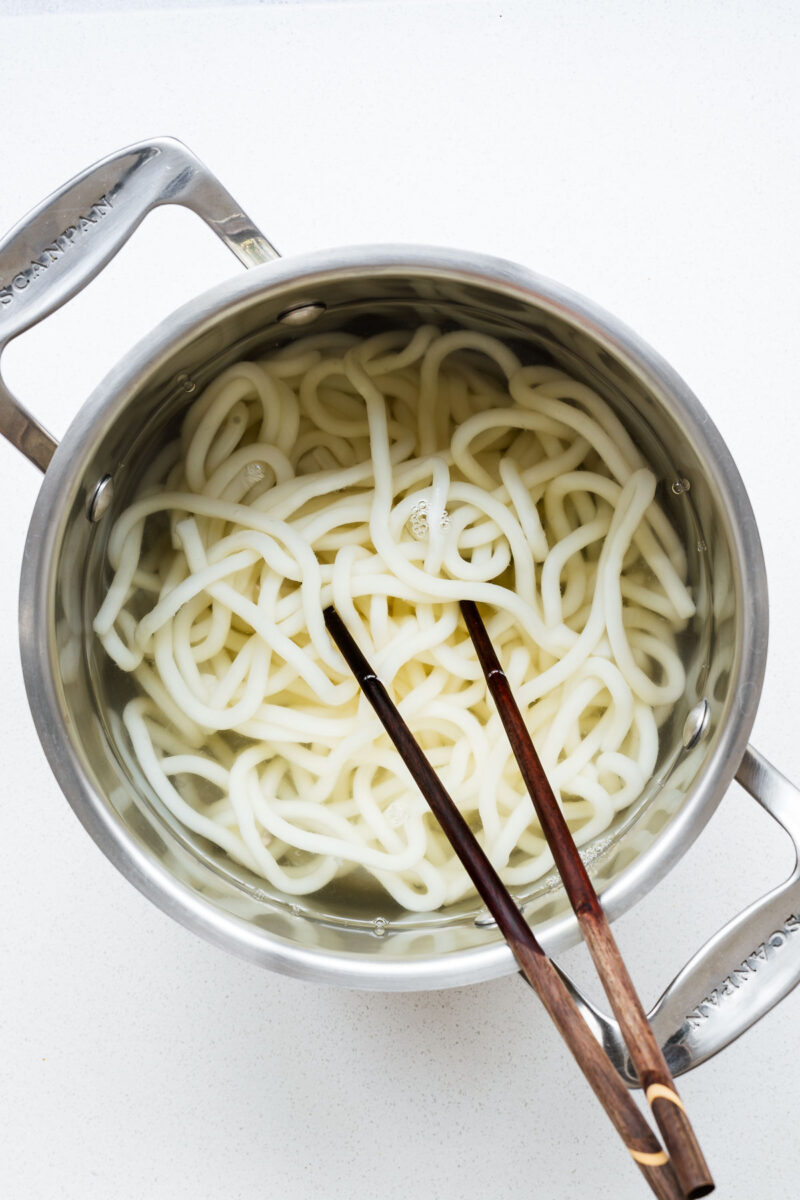
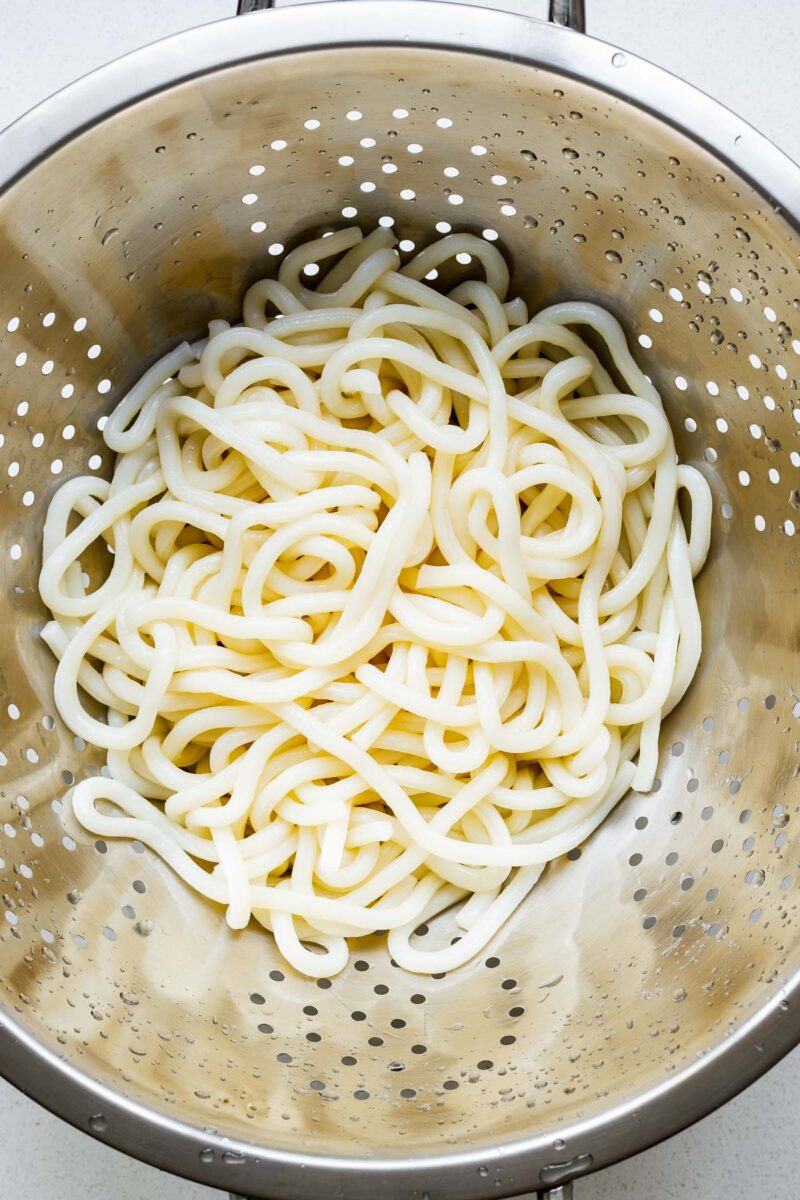
Step 3: Simmer the gochujang noodle sauce
Place a wok or non-stick pan over medium-high heat and add a tablespoon of neutral cooking oil. Once the oil is shimmering hot, add the green onions and stir-fry for a minute or two before you add the minced garlic. Cook for another minute until the garlic is fragrant – take care not to burn the garlic.
Add the gochujang sauce to the aromatics (be careful, it might sputter). And cook the sauce to thicken for 3 minutes, stirring often.
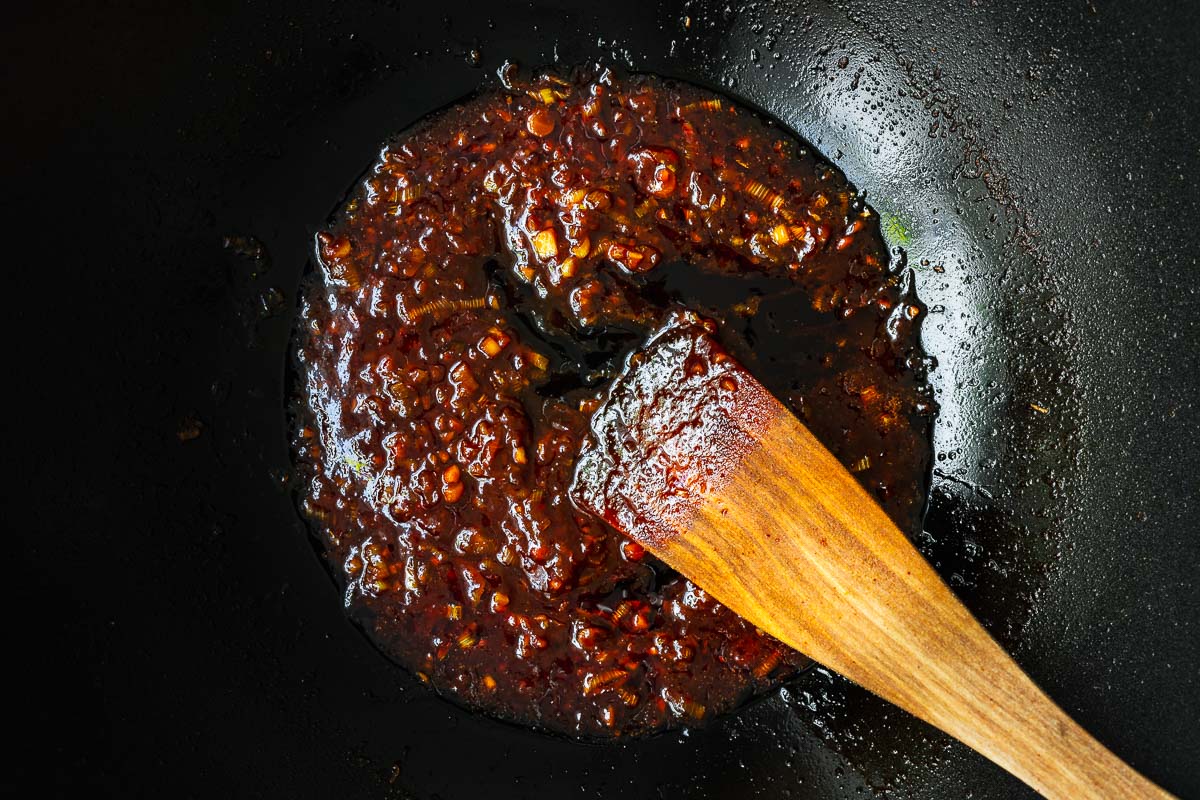
Step 4: Finish the noodles
Add the cold noodles and cook for a minute to heat through. Then stir through the toasted sesame seeds.
Transfer the noodles to serving bowls and top with the reserved green onions. Serve the spicy Korean noodles warm or at room temperature. And top it with a fried egg with a super runny yolk if you don’t need it to stay vegan.
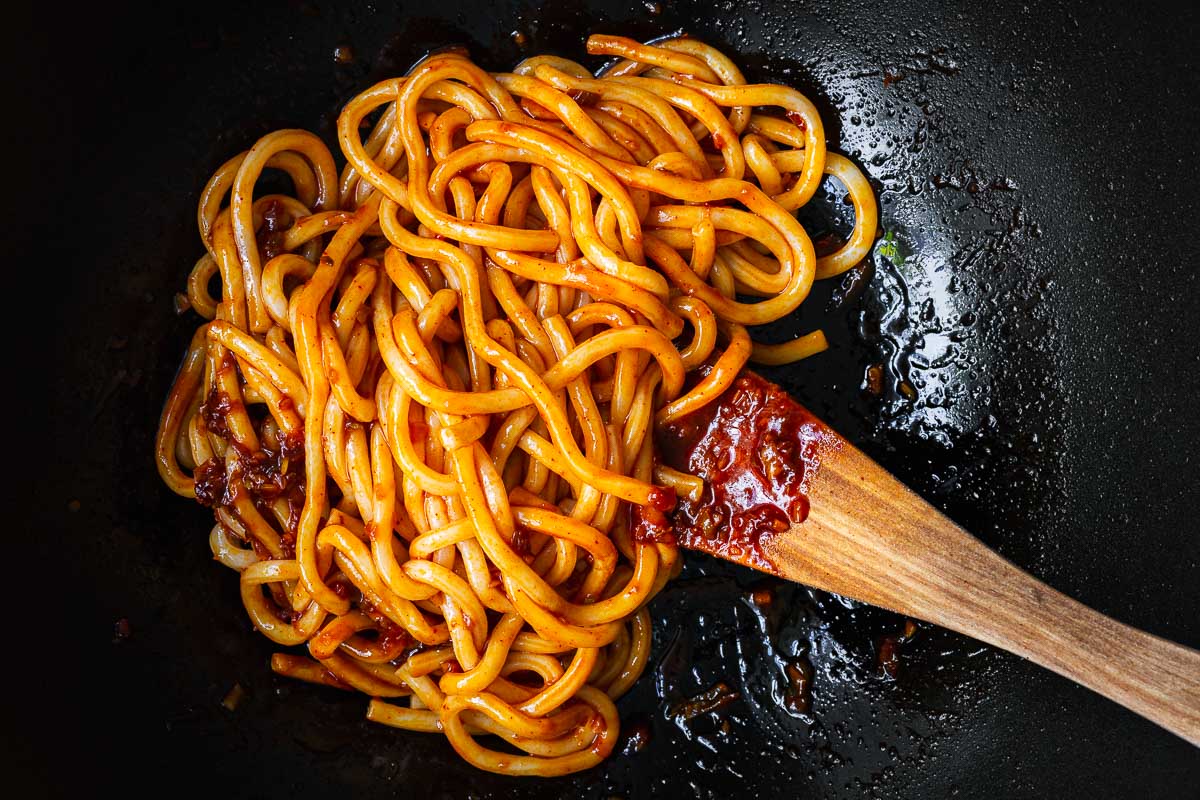
Gochujang noodle variations
These spicy Korean noodles are super yummy as is. But the portions are quite small.
Luckily they’re easy to bulk up to suit your appetite and pantry:
- Gochujang tofu noodles: Cut firm tofu into squares and pan-fry until brown on all sides before you start with the gochujang noodle recipe. Then return the tofu to braise in the gochujang sauce before you add the noodles. See this recipe for Gochujang tofu (spicy Korean braised tofu) for more instructions.
- Rainbow gochujang noodles: Add shredded cabbage, carrot sticks, and red bell pepper strips and stir-fry with the spring onions before adding the noodles. Drizzle with hoisin peanut sauce for a nutty umami boost.
- Gochujang noodle soup: Turn the spicy noodles into a comforting noodle soup. Mix the gochujang noodle sauce with two cups of vegetable or chicken broth. Follow the recipe and simmer the soup to allow the flavours to meld, then add the noodles. Or simply mix the gochujang noodle sauce into instant ramen. Serve the soup with a drizzle of toasted sesame oil and a sprinkle of gochugaru flakes with Korean green onion salad on the side.
- Spicy mushroom noodles with egg (non-vegan version): Add a cup of sliced shiitake mushrooms with the spring onions. Stir-fry until golden, then add the garlic and continue with the spicy Korean noodle recipe. Or, simply stir in some roasted oyster mushrooms. Finish the noodles with a fried egg or a raw egg yolk (if this is your thing, you’ll LOVE the combination of runny yolk and gochujang sauce), and a cheeky dollop of miso butter.
I hope these variations and optional add-ins inspire you to get creative with your spicy gochujang noodles. Let me know in the comments below if you have any other ideas or tips to share!
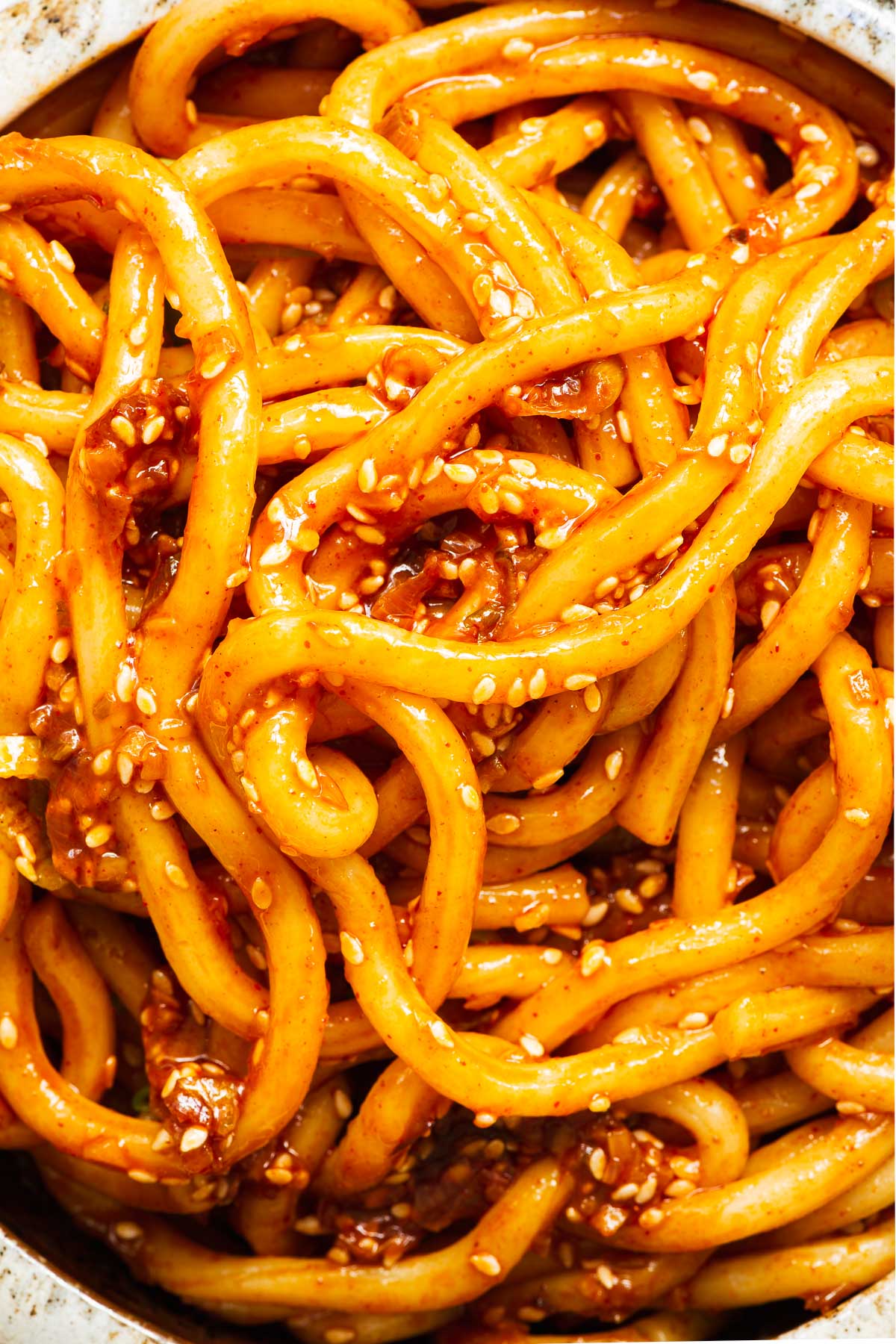
Leftovers storage instructions
If you have any leftover noodles (highly unlikely), refrigerate them in an airtight container for up to four days.
To reheat, simply add a splash of water and gently reheat in a pan or microwave for 1-2 minutes.
Or eat the noodles cold, topped with mayak egg (Korean soy-marinated eggs) for an easy leftover snack meal.
Love gochujang?
If you loved these spicy Korean-style gochujang noodles, why not try another one of my favourite recipes with gochujang?
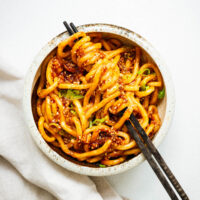
Ingredients
- 14 ounces instant fresh udon noodles*
- 1 tablespoon neutral cooking oil
- 3 green onions, sliced (reserve some greens for garnish)
- 2 cloves garlic, minced
- 3 tablespoons sesame seeds, toasted
Gochujang noodle sauce
- 2 tablespoons gochujang paste or more for a spicier sauce
- 2 tablespoons soy sauce
- 2 tablespoons water
- 2 tablespoons rice vinegar
- 1 tablespoon toasted sesame oil
- 1 tablespoon brown sugar
- 1 teaspoon gochugaru (Korean chilli flakes) or red pepper flakes (optional)
Instructions
- Place all the gochujang noodle sauce ingredients – except the optional chilli flakes – in a bowl and whisk to combine. Taste, and add an extra tablespoon of gochujang or a teaspoon of gochugaru if you want more heat. Set aside until needed.
- For fresh udon noodles: Boil water in a pot over high heat. Then cook the fresh udon noodle cakes in boiling water for 2 minutes. Remove the pot from the heat, and use chopsticks to wiggle into the noodles and gently separate them.
- For dried noodles: Cook the noodles according to package instructions stopping a minute short of the full cooking time.
- Drain the cooked noodles, and rinse with cool water.
- Place a wok or non-stick pan over medium-high heat and add the cooking oil. Once the oil is shimmering hot, add the green onions and stir-fry for a minute or two before you add the minced garlic. Cook for another minute until the garlic is fragrant.
- Add the gochujang sauce to the aromatics (be careful, it might sputter). Then cook the sauce to thicken for 3 minutes, stirring often.
- Add the cold noodles and cook for a minute to heat through. Then remove from the heat and stir through the toasted sesame seeds.
- Transfer the noodles to serving bowls and top with the reserved green onions and a sprinkle of chilli flakes if you want extra heat.
Notes
- The udon noodle package may say “pre-cooked”, “wok-ready”, “fresh noodles” or “instant fresh Japanese noodles”. They are thick, white noodles in vacuum-sealed clear plastic (see ingredients and substitutes section for more information). Follow the same cooking instructions for frozen udon noodles, but boil them for a minute longer.
- I love how the gochujang noodle sauce clings to thick, chewy udon noodles. But you can use any Asian wheat noodle in this recipe. Adjust the portion size according to the dried noodle packaging (ramen noodle portions are typically around 2 oz).
- Gochujang is available in different levels of spiciness: Mild, Slight Hot, Medium Hot, Very Hot and Extreme Hot. I buy mine medium hot and add gochugaru (Korean chilli flakes) if I want more heat. Find more information on gochujang and how to substitute it if you’ve run out.
- I prefer these spicy noodles served warm. But you can also serve them at room temperature.
- Refrigerate leftovers in an airtight container for up to 4 days and reheat with a splash of water.
- See the full post for gochujang noodle variations and optional add-ins to bulk up your noodles.
More Korean-inspired recipes you may like
If you like this lemon tahini sauce, you might also like these tahini dressings and sauces


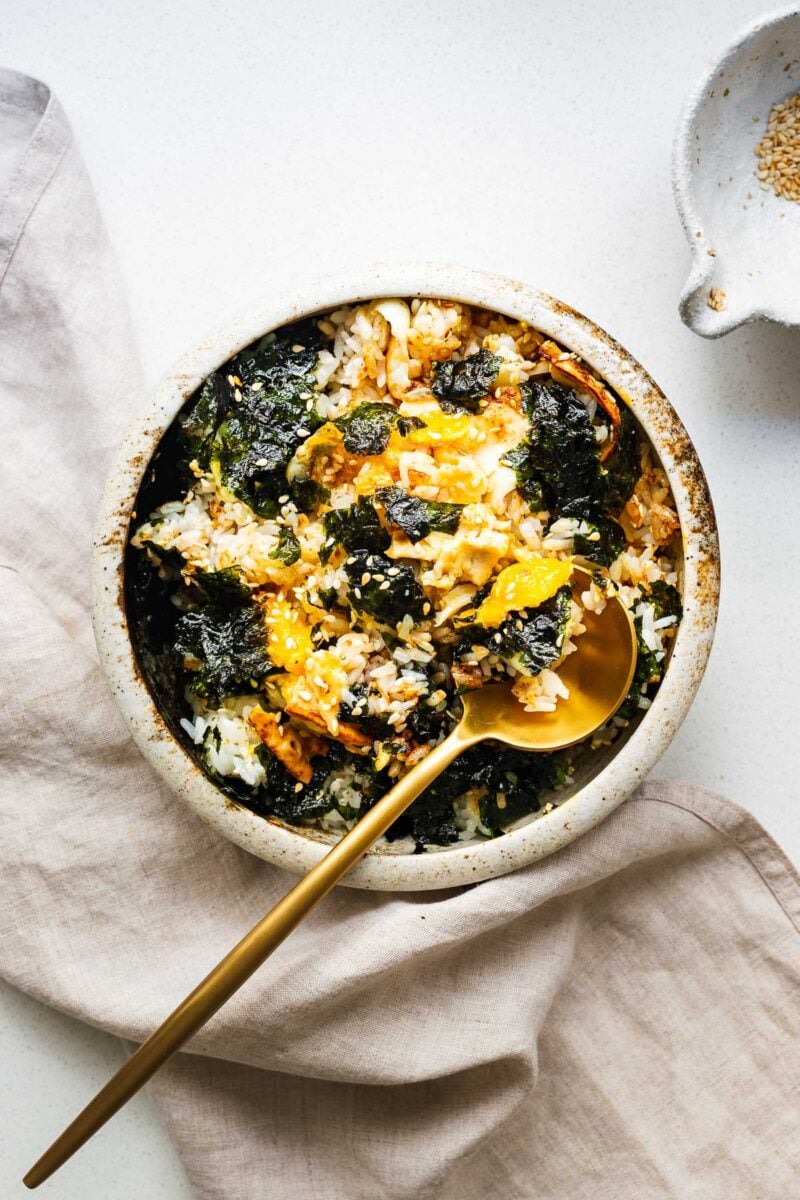
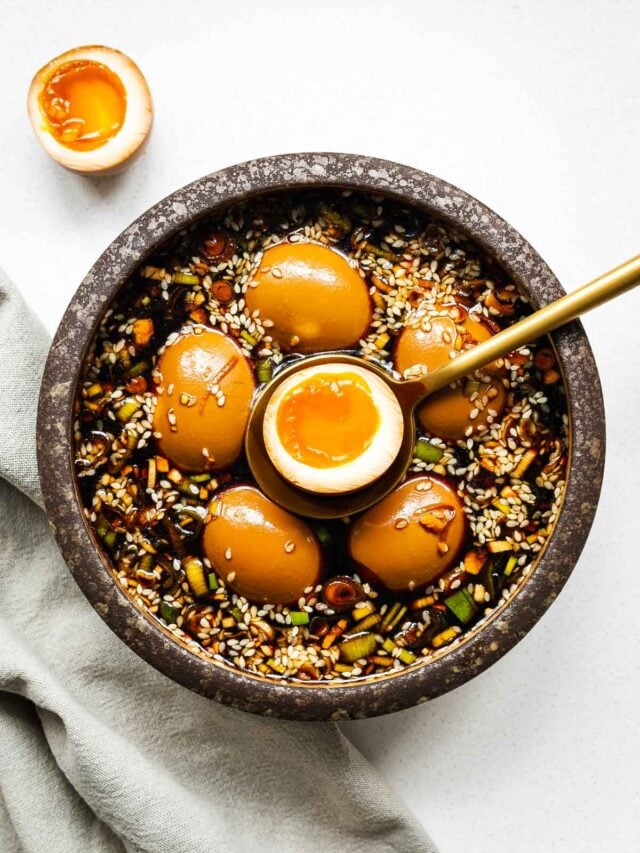

I have made this a number of times. Just as written it is quite good! But I have also added in Spam or shrimp as a protein and both were excellent I also swapped out black garlic vinegar in place of rice vinegar and that gives it a darker look and flavor. Adding in some red pepper is good as well.
Cheers!
I love your addition of black garlic vinegar. And, I agree, it’s super easy to customise the recipe with some proteins or any veggies lying in the fridge! Most of all, I’m so happy you are enjoying the recipe and making it your own! 🥰 Thank you for sharing your delicious ideas.
Drooling over this Korean noodles. Can’t wait to try this recipe.
It’s so easy and delicious, you should definitely give them a go!
My wife and I made these for a dinner date and we really enjoyed the company and the meal! Thank you so much!
I’m so happy you enjoyed the noodles (and the company 😁), Ned!
WOW, these Gochujang Noodles are super yummy and so easy to make too! A total winning recipe, thanks so much!
Yay! I’m so happy you loved the noodle recipe, Heather. It really is a dinnertime win, so ridiculously easy and versatile!
These spicy noodles are so yummy! I LOVE udon noodles and the easy gochujang sauce was incredible. Not to mention this was ready in less than 20 minutes. It’ll be on constant rotation in our house!
I’m so happy you loved the noodles, Ashley! It really is such a flavour-packed noodle bowl that’s ready in no time. It features very often on our dinner rotation too!